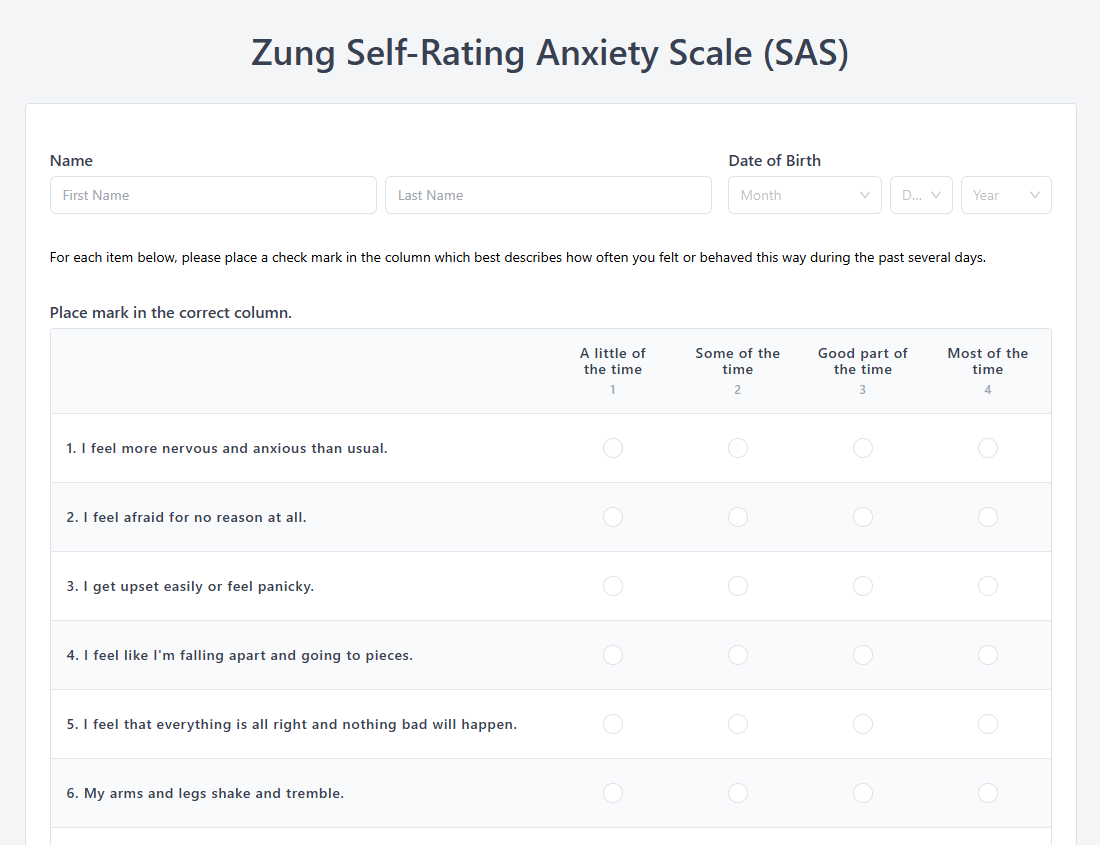The Zung Self-Rating Anxiety Scale (SAS) is a widely used psychological assessment tool designed to measure a patient’s level of anxiety. Developed by Dr. William W.K. Zung, this 20-item self-report questionnaire evaluates both psychological and physical symptoms of anxiety. It provides a standardized, validated method for clinicians to identify severity, track changes over time, and support treatment planning.
Why Healthcare Providers Use the Zung SAS
- Validated Anxiety Screening
Offers a reliable, standardized way to measure anxiety severity across different populations. - Supports Treatment Planning
Helps providers determine the need for therapy, medication, or further evaluation. - Progress Monitoring
Tracks patient improvement or worsening symptoms during treatment. - Insurance & Documentation
Provides measurable data often needed for mental health billing, compliance, and insurance claims. - Patient Engagement
Encourages self-awareness and discussion by helping patients better understand their anxiety symptoms.
Clinical Applications
The Zung SAS is broadly applicable across multiple specialties that manage anxiety-related concerns:
- Primary Care Providers: Screen patients who present with somatic complaints or stress-related symptoms.
- Mental Health Professionals (Psychologists, Therapists, Counselors): Establish a baseline and monitor therapy effectiveness.
- Psychiatrists: Support diagnosis and track medication response.
- Pain Management Clinics: Assess anxiety that may amplify perception of pain.
- Specialty Clinics (Cardiology, Endocrinology, Gastroenterology): Evaluate anxiety in patients with chronic illness where mental health overlaps with physical symptoms.
- Occupational Health & Employee Wellness Programs: Screen for workplace-related stress and anxiety disorders.
Zung SAS Components and Scoring
- 20 Questions: Cover a mix of affective and somatic symptoms of anxiety (e.g., restlessness, palpitations, nervousness, trembling, insomnia).
- Scoring System:
- Each item scored on a 1–4 scale (a little of the time → most of the time).
- Raw score range: 20–80.
- Index Score: Raw score × 1.25 (range 25–100).
- Interpretation:
- 20–44 (Index <45): Normal range
- 45–59: Mild to moderate anxiety
- 60–74: Marked to severe anxiety
- 75–100: Extreme anxiety
Common Conditions Assessed
- Generalized Anxiety Disorder (GAD)
- Panic Disorder
- Social Anxiety Disorder
- Post-Traumatic Stress Disorder (PTSD)
- Phobias
- Anxiety secondary to chronic medical conditions
Administration Best Practices
- Initial Evaluation: Use at intake to establish an anxiety baseline.
- Ongoing Monitoring: Repeat at regular intervals to measure treatment effectiveness.
- Patient Instructions: Patients respond based on symptoms experienced in the past week.
- Scoring Consistency: Train staff to calculate and interpret results uniformly.
- Integration: Store scores in EMRs, progress notes, or billing documentation to support evidence-based care.

